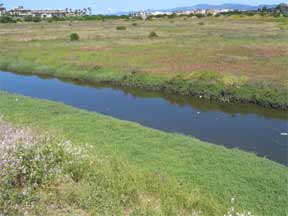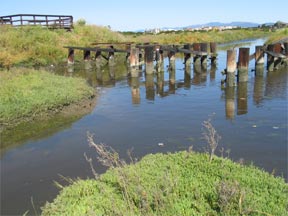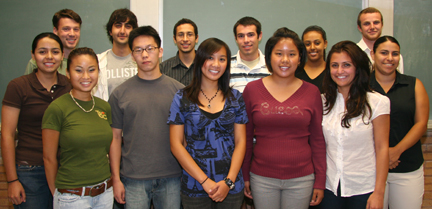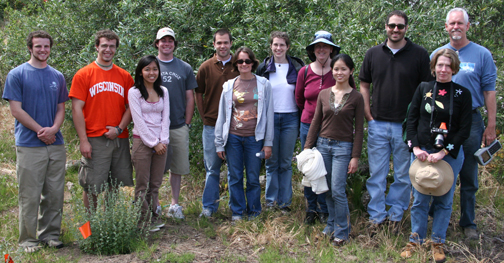2006 - 2008
Ballona Wetlands Research
|Student Research Symposium|Call for Applications|Faculty|Students|Projects|Contact|


Call for Applications (Applications for 2008 have closed)
- Five Research Associate positions available; each student mentored by two faculty members
- Interdisciplinary projects combine biology and chemistry, field and laboratory research
- $3000 stipend
- On-campus housing will be provided
- 10 week program, May 19 - July 25, 2008
- Download Flyer (pdf format)
- Download Application (pdf format)
Top
Interdisciplinary Student Research Symposium
- Friday, October 26, 2007
- 2:00PM, Seaver 200, Keynote address by Dr. Frances Solomon, University of British Columbia, "Puget Sound Urban Bay Action Program"
- 3:00-5:00PM, Seaver Second Floor, Poster Session & Reception (refreshments will be served!)
- Download Flyer (pdf format)
- Poster Abstracts
Participating Faculty
- Biology: Dr. Kam Dahlquist, Dr. Philipa Drennan, Dr. Gary Kuleck, Dr. Martin Ramirez, Dr. Carl Urbinati
- Chemistry & Biochemistry: Dr. Lambert Doezema, Dr. Jeremy McCallum, Dr. David Moffet
- Civil Engineering & Environmental Science: Dr. Rachel Adams
- Natural Science: Dr. John Dorsey, Dr. Jim Landry
For more information contact:
Dr. Kam Dahlquist, Director, Merck/AAAS Undergraduate Research Program at LMU, kdahlquist [at] lmu [dot] edu.
Top
Participating Students
2008
Arthur Blikian, Biology, '09
Molly Bogeberg, Biology, '10
Patrick Stahl, Civil Engineering, '10
Kara Taylor, Biology, '09
Viviana Vallin, Biology '09
2007
Arthur Blikian, Biology, '09
James Holmquist, Biology, '08
Jeff McGowan, Biology, '08
Anh Nguyen, Civil Engineering, '09
Jaclyn Torres, Biology, '08
 |
Summer 2007 Merck/AAAS (red) and Top row, left to right: Jeff McGowan, Arthur Blikian, Kenny Rodriguez, Kevin Entzminger, Bethy Woubeshet, James Holmquist Bottom row, left to right: April Garcia, Anh Nguyen, Jonathan Park, Aimee Cruz, Farah Srichandra, Anita Aynehchi, Jaclyn Torres (Stephanie Kuelbs not shown) |
|---|
2006
Patrick Carter, Environmental Science, '07 (currently enrolled in a Master's program in Environmental Science at LMU)
Wesley Citti, Biology, '08
James Holmquist, Biology, '08
Theresa Nguyen, Biochemistry, '08
Charisse Sy, Biochemistry, '08
 |
Summer 2006 Merck/AAAS Research Associates and Faculty Top Row, left to right: James Holmquist, Wes Citti, Patrick Carter, Dr. Lambert Doezema, Dr. Rachel Adams, Dr. Kam Dahlquist, Dr. Carl Urbinati, Dr. John Dorsey Bottom Row, left to right: Theresa Nguyen, Jaime Sayre (guest from USC) , Charisse Sy, Dr. Philippa Drennan (Other participating faculty not shown) |
|---|
Projects
As the last remaining wetlands of significant size in Los Angeles County, the Ballona Wetlands is not only a valuable environmental resource for Southern California but has also proven to be an outstanding teaching and research laboratory for LMU. It provides a unique venue to study an urban-wildlands interface in all its dimensions and is especially well-suited for projects involving undergraduates. Its proximity at less than a mile from the LMU campus allows easy access for sampling, reinforces the practical contribution that research can make, and underscores the interdisciplinary nature of the real world. Understanding an urban wetlands requires the intimate integration of chemical, biological, and biochemical approaches. Ballona provides a remarkable opportunity to study urban wetlands at a crucial period. These wetlands have been degraded by decades of anthropogenic disturbances including oil production activities, land development, tidal gates and channelization, contamination of its freshwater flows by urban runoff, and air pollution derived from traffic, the airport and other urban influences. An ecological preserve has been created which will protect the remaining wetlands from development in perpetuity. Restoration is underway; however, the wetlands remain vulnerable to the impact of its urban watershed and atmosphere. These five projects will increase our understanding of the chemistry and biology of the Ballona Wetlands and identify some of the biochemical pathways organisms use to respond to the environmental challenges of urbanization. Follow the links below to the current abstracts.
- Developing Salicornia virginica as a Bio-monitor for Heavy Metals in the Ballona Wetlands
James R. Holmquist (Mentors: Dr. Philippa Drennan and Dr. James Landry) - Biomagnification of Wetland Contaminants in Garden Spiders
Jaclyn Torres and Charisse Sy (Mentors: Dr. James Landry, Dr. Jeremy McCallum, and Dr. Martin Ramirez) - Freely Dissolved Concentrations of Selected PCBs, PAHs, and Chlorinated Pesticides in Ballona Wetland and Creek
Anh P. Nguyen (Mentor: Dr. Rachel G. Adams) - Survey of Microorganisms in the Ballona Wetlands
Arthur Blikian (Mentors: Dr. Gary Kuleck and Dr. John Dorsey) - Identifying Soil Bacteria and Biochemical Pathways in the Ballona Wetlands for the Bioremediation of Organic Pollutants
and Analysis of Organic Compounds in the Ballona Atmosphere
Wesley T. Citti and Jeffrey D. McGowan (Mentors: Dr. Kam Dahlquist, Dr. Lambert Doezema, and Dr. Carl Urbinati)
This award program is funded by The Merck Institute for Science Education and administered by the American Association for the Advancement of Science.
|Student Research Symposium|Call for Application|Faculty|Students|Projects|Contact|Top|
|Dahlquist Lab|Biology|Chemistry & Biochemistry|Civil Engineering & Environmental Science|Natural Science|
|Frank R. Seaver College of Science and Engineering|Loyola Marymount University|
Last modified:4/1/2008
This web page is not an official Loyola Marymount University web page. Comments on this page should be directed to kdahlquist[at]lmu[dot]edu.